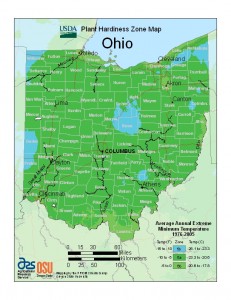 The USDA recently updated their Plant Hardiness Zone maps. The new map reflects that warmer temperatures allow less-hardy plants to survive Ohio winters. Columbus (and most of Ohio) is now in Zone 6a, an upgrade from Zone 5b. Not in Columbus? Check out the interactive map to find your Zone.
It must be noted that the Arbor Day Foundation came to the same hardiness zone conclusion in 2006. Both groups say that this is not necessarily a reflection of climate change but better data mapping. I think it must be a combination of climate change, heat island effect, and natural variability.
The USDA recently updated their Plant Hardiness Zone maps. The new map reflects that warmer temperatures allow less-hardy plants to survive Ohio winters. Columbus (and most of Ohio) is now in Zone 6a, an upgrade from Zone 5b. Not in Columbus? Check out the interactive map to find your Zone.
It must be noted that the Arbor Day Foundation came to the same hardiness zone conclusion in 2006. Both groups say that this is not necessarily a reflection of climate change but better data mapping. I think it must be a combination of climate change, heat island effect, and natural variability.
What does this mean for fruit and vegetable gardeners?
First, some annuals can now be grown as perennials. Many herbs such as rosemary, thyme, and oregano will pop up in the spring and not require re-planting. Greens allowed to go to seed may reseed themselves.
Some fruit trees previously thought to be too difficult to keep through the winter may now be planted outside. Fig trees may grow more successfully with lessor no cool weather care. Peaches, nectarines, and cherries will have a better chance of setting fruit.
The Zone reclassification means that our last-frost date edges towards the beginning of May and the first-frost date more towards the end of October. I have long planted annuals outside starting on May 1. Cold-weather crops like kale, swiss chard, peas, lettuces, and beets, can be seeded as early as April 1.
Essentially, gardeners can move everything up a few weeks and hope to have a slightly extended season in the fall too. Sweet potatoes become a more likely success. It may be possible to fit in more succession plantings of beans.
Personally, this rezoning will not change my garden habits much as I am already accustomed to pushing the planting dates a bit. I may, however, finally plant our very overgrown potted fig tree outside this year.
How will the new Zone affect you?
